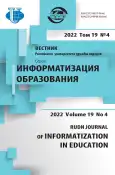Особенности применения игровых механик в обучении информатике для развития креативного мышления школьников
- Авторы: Михлякова Е.А.1, Старкова Е.К.2, Батакова Е.Л.3
-
Учреждения:
- МКОУ СОШ с углубленным изучением отдельных предметов д. Стулово
- Российский химико-технологический университет имени Д.И. Менделеева
- МАОУ СОШ «НьюТон» г. Чайковского
- Выпуск: Том 19, № 4 (2022)
- Страницы: 340-350
- Раздел: ВЛИЯНИЕ ТЕХНОЛОГИЙ НА РАЗВИТИЕ ОБРАЗОВАНИЯ
- URL: https://journal-vniispk.ru/2312-8631/article/view/321297
- DOI: https://doi.org/10.22363/2312-8631-2022-19-4-340-350
- ID: 321297
Цитировать
Полный текст
Аннотация
Постановка проблемы. Одна из приоритетных задач современного общества - создание условий, способствующих воспитанию и развитию креативной личности. Курс информатики обладает дидактическим потенциалом в плане формирования инициативности, самостоятельности, фантазии, умений ставить и решать задачи. Представленное исследование направленно на обоснование эффективности использования игровых механик при обучении информатике для решения проблемы, связанной с необходимостью развития креативного мышления школьников. Методология. Механики «Достижение», «Расчет на доверие», «Весело один раз - весело всегда», «Прогресс пользователя» реализованы при включении игровых элементов и методов в изучение теоретической информатики. Для геймификации применяются ресурсы цифровых сервисов (интерактивные доски, генераторы случайного выбора). База эксперимента - средняя общеобразовательная школа с углубленным изучением отдельных предметов д. Стулово (Слободской район Кировской области). Исследованием охвачено 74 обучающихся седьмых классов (64 % - девушки и 36 % - молодые люди). Средний возраст респондентов - 13 лет. Статистическая обработка результатов выполнена с помощью критерия хи-квадрат Пирсона. Результаты. В процессе игры обучающиеся изучают теоретический материал, решают систему творческих и нестандартных заданий по теме «Измерение информации». Для каждой игровой механики определены цель, задачи, наборы правил и ограничений. Выявлены статистически достоверные различия в качественных изменениях, произошедших в системе по уровням развития креативного мышления. Заключение. Описаны особенности представленного варианта применения игровых механик при обучении информатике в плане развития креативного мышления: учет возрастных особенностей школьников при формулировании текстов сообщений, включение цифровых сервисов, комбинирование устной и письменной речи и взаимодействия по компьютерной сети.
Об авторах
Елена Александровна Михлякова
МКОУ СОШ с углубленным изучением отдельных предметов д. Стулово
Автор, ответственный за переписку.
Email: tutor.stulovo@gmail.com
ORCID iD: 0000-0003-4659-7255
заместитель директора по учебной работе, учитель информатики высшей категории
Российская Федерация, 613112, Кировская область, Слободской район, ул. Трактовая, д. 33Екатерина Константиновна Старкова
Российский химико-технологический университет имени Д.И. Менделеева
Email: starkova.kate@mail.ru
ORCID iD: 0000-0001-8613-9430
преподаватель кафедры иностранных языков
Российская Федерация, 125047, Москва, Миусская пл., д. 9Евгения Леонидовна Батакова
МАОУ СОШ «НьюТон» г. Чайковского
Email: hermanny@mail.ru
ORCID iD: 0000-0002-9466-5702
учитель информатики высшей категории
Российская Федерация, 617762, Чайковский, ул. Алексея Кирьянова, д. 1Список литературы
- Halpern DF. Teaching for critical thinking: helping college students develop the skills and dispositions of a critical thinker. New Directions for Teaching and Learning. 1999;(80):69-74. http://doi.org/10.1002/TL.8005
- Fazylzianova GI, Sokolova ТYu, Balalov VV. Gamification trends in educational communications in a digital society. Economic and Social Research. 2021;(1):105-110. http://doi.org/10.24151/2409-1073-2021-1-105-110
- Isupova NI, Suvorova ТN. Gamification of the educational process using the “flipped classroom” technology. Perspectives of Science and Education. 2019;(5):412-427. http://doi.org/10.32744/pse.2019.5.29
- Soboleva EV, Suvorova TN, Bocharov MI, Bocharova TI. Development of the personalized model of teaching mathematics by means of interactive short stories to improve the quality of educational results of schoolchildren. European Journal of Contemporary Education. 2022;11(1):241-257. http://doi.org/10.13187/ejced.2022.1.241
- Suyundikova MK, Zhumataeva EO, Suyundikov MM, Snopkova EI. Prerequisites defining the trajectory of creative thinking. Education and Science Journal. 2021;23(3):75-100. http://doi.org/10.17853/1994-5639-2021-3-75-100
- Muhammadiyeva H, Mahkamova DK, Valiyeva S, Tojiboyev IU. The role of critical thinking in developing speaking skills. International Journal on Integrated Education. 2020;3(1):62-64. http://doi.org/10.31149/ijie.v3i1.273
- Dichev Ch, Dicheva D. Gamifying education: what is known, what is believed and what remains uncertain: a critical review. International Journal of Educational Technology in Higher Education. 2017;14:9. http://doi.org/10.1186/s41239-017-0042-5
- Dyson S, Chang Y, Chen H-Ch, Hsiung H-Yu, Tseng Ch-Ch, Chang J-H. The effect of tabletop role-playing games on the creative potential and emotional creativity of Taiwanese college students. Thinking Skills and Creativity. 2016;(19):88-96. http://doi.org/10.1016/j.tsc.2015.10.004
- Hamada M, Hassan M. An interactive learning environment for information and communication theory. Eurasia Journal of Mathematics Science and Technology Education. 2017;13(1):35-59. http://doi.org/10.12973/eurasia.2017.00603
- Cakiroglu U, Basibuyuk B, Guler M, Atabay M, Memis BY. Gamifying an ICT course: influences on engagement and academic performance. Computers in Human Behavior. 2017;69:98-107. http://doi.org/10.1016/j.chb.2016.12.018
- Sergeeva ОV. Development of research computer game: how new ontology helps to cope with the methodological challenges in sociology. Sociology of Science and Technology. 2021;12(3):171-184. http://doi.org/10.24412/2079-0910-2021-3-171-184
- Vekua NN, Lubsky AA, Perevozchikova MS, Folgеrоva JuN. Peculiarities of forming high-demanded soft skills in the educational space of the escape room. Perspectives of Science and Education. 2020;(6):397-412. http://doi.org/10.32744/pse.2020.6.31
- Mauroner O. Gamification in management and other non-game contexts - understanding game elements, motivation, reward systems, and user types. Open Journal of Business and Management. 2019;7:1815-1830. http://doi.org/10.4236/ojbm.2019.74125
- Parfenova GL, Kholodkova ОG, Melnikova JuА. Complex psychological and educational support for gifted children in social and educational space: description of the model. Science for Education Today. 2019;9(6):88-105. http://doi.org/10.15293/2658-6762.1906.06
- Safonov КV, Ischukova ЕА, Zolotarev VV. Application of gamification elements in the training of students - future specialists in the field of information security. Perspectives of Science and Education. 2021;(1):450-463. http://doi.org/10.32744/pse.2021.1.31
- Guilford JP. Creativity. American Psychologist. 1950;5:444-454. http://doi.org/10.1037/h0063487
Дополнительные файлы









